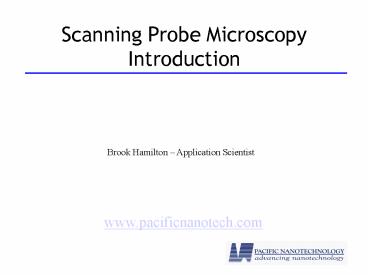Scanning Probe Microscopy Introduction - PowerPoint PPT Presentation
1 / 32
Title:
Scanning Probe Microscopy Introduction
Description:
In 1929, Smaltz described a tracer instrument using. a tilting mirror and a long light arm to obtain the. necessary magnification. Past - Profilers ... – PowerPoint PPT presentation
Number of Views:95
Avg rating:3.0/5.0
Title: Scanning Probe Microscopy Introduction
1
Scanning Probe MicroscopyIntroduction
Brook Hamilton Application Scientist
www.pacificnanotech.com
2
Outline
- History
- Instrumentation
- Applications
3
Mechanical Profilers
Mechanically Scan A Probe Over A Surface
Z Height
X Distance
4
Past Profilers
In 1929, Smaltz described a tracer instrument
using a tilting mirror and a long light arm to
obtain the necessary magnification.
5
Past - Profilers
- 1955 - Vibrating tip profiler - From null point
to surface - Piezo activated Motion - Piezo
detection of surface
Becker U.S. 2,728,222
6
Past TopoGraphiner
- 1972 - Non-contact profiler - X,Y,Z Piezo -
Constant current feedback
7
Past Scanning Tunnelling Microscope
- 1982 - Needle Close to Surface - Reduce
Vibrations - x,y,z Piezoelectrics/Feedback
Pictures of Atoms !!!
8
Atomic Force Microscope
- Piezoelectric Ceramics
- Sensor/Probe/Cantilever
- Modes
9
Piezoelectric Ceramics
- Electrical Mechanical Transducer - Nanometers
Configured to Generate 3-D motion Tubes,
Tripods, Flexures
10
Piezoelectric Ceramics
Hysteresis
Displacement, m
Ideal Actual
Voltage, V
Creep
Displacement, m
Time, s
11
Piezoelectric Problems
Zoom to Feature
First Scan
Zoomed image
Second Scan
12
Motion Control
- Piezoelectric Ceramic Calibration Sensor
Piezo
Motion Sensor
PID
Sensor Electronics
13
Measurements
Step Height Standards - gt 18 nm Pitch Standards -
gt ½ Micron
14
Accurate, Fast
- Zoom on feature, 5?mx5?m image
- 87?mx87?m image
- of polipeptide film
15
Atomic Force Microscope - Sensor
16
Cantilever/Probe
F - k D (hooks law)
F Force k Force Constant D Displacement E
Youngs modulus W Cant. Width T Cant.
Thickness L Cant. Length D Density
3
Force Constant k EW T
4 L
Resonance Frequency f .162 E T
D L
2
17
Probes - Resolution
18
Probes
Si Probe
Nanotube Probe
Diameter lt 20 nm
Diameter 2 nm
19
Probes Artifacts
20
Imaging Modes
Continuous Mode Contact Mode Repulsive Region
Vibrating Mode Non-Contact Intermittent
Contact "Tap"
Material Sensing Modes Lateral Force Vibrating
Phase
21
Continuous - Contact
Probe
Contact Point
Surface
Potential
Distance
22
Potential Diagram
Repulsive Cantilever pushed up
Distance
Potential
AttractiveCantilever pulled down
23
Continuous - Contact
Cantilever(Si) Force constant .2 N/m
Resonance 13 kHz
W/T/L 50/2/450 (µ)
Applications Hard Samples Learning to use
AFM Lower Resolution (gt50 nm)
24
Vibrating Mode
Probe
Potential
Surface
Distance
- The tip is vibrated in and out of the potential
associated with the surface.- Large or small
amplitudes- Advantages are low forces, reduced
lateral forces
25
Vibrating Modes
Feedback set-point is selected to keep the
vibration amplitude constant while scanning.
Vibration Amplitude
Frequency
26
Vibrating Modes
Cantilever Force Constant 42 N/M Resonant
Frequency 330 KHz W/T/L 30/4/12
5 (µ) Applications Sharp Probes Soft
Samples Features loosely held to a surface
It is best not to Tap the probe because this can
cause probe/sample damage.
27
Vibrating Phase
- The probe is vibrated as it is scanned across the
surface - Monitor phase changes between the driving and
senor signal
Driving Signal
AFM Sensor Signal
White Region
Yellow Region
28
Vibrating Mode - Example
Topography
Vibrating Phase
Triblock co-polymer styrene butadyene
styrene(SBS) Scan range 1.5 X 1.5 µ
29
Lateral Force (Frictional force)
Torsional motion of Cantilever
Scan Direction
Topography profile Friction profile
High friction Low Friction
30
Example
Topography
Lateral Force
6 X 6 µ scan of composite sample with coating
31
AFM Applications
High Technology - Semiconductor - Data
Storage - Life Sciences Physical Sciences -
Physics - Polymers - Chemistry -
Materials Life Sciences - Bio-molecules -
Bio-materials - Cells
32
Conclusion
- AFM is derived from profiler techniques
- Instrumentation Scanners(piezoelectric) Probes
Scanning modes - Applications in all areas































